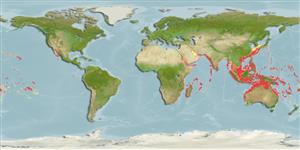Common names from other countries
>
Eupercaria/misc (Various families in series Eupercaria) >
Priacanthidae (Bigeyes or catalufas)
Etymology: Priacanthus: Greek, prion = saw + Greek, akantha = thorn (Ref. 45335).
Environment: milieu / climate zone / depth range / distribution range
Ecologia
marinhas associadas(os) a recifes; intervalo de profundidade 0 - 250 m (Ref. 9710). Tropical; 36°N - 36°S, 24°E - 109°W
Indo-Pacific: Red Sea and southern Africa to French Polynesia, north to southern Japan, south to Australia. Reported from Easter Island (Ref. 33390).
Length at first maturity / Tamanho / Peso / Idade
Maturity: Lm 22.0 range ? - ? cm
Max length : 45.0 cm TL macho/indeterminado; (Ref. 4328); common length : 40.0 cm TL macho/indeterminado; (Ref. 5450)
Espinhos dorsais (total) : 10; Raios dorsais moles (total) : 13 - 15; Espinhos anais: 3; Raios anais moles: 13 - 16. This species is distinguished by the following characters: body depth 2.5-2.9 in SL; poorly developed preopercular spine, reduced or inconspicuous to non-existent in adults (> 12.5 cm TL); total gill rakers in first gill arch 24-26; soft portion of dorsal fin taller than spinous portion, angular posteriorly; pectoral fins shorter than pelvic spine; pelvic fins long, reaching posterior to spinous portion of anal fin; distinctly emarginate caudal fin; scales modified, the posterior field elevated as a separate flange with spinules both on surface and posterior margin; vertical scale rows (dorsal-fin origin to anus) 48-57; swimbladder with pair of anterior and posterior protrusions. Colour of body entirely red or capable of quickly changing to silvery with about 6 red bars or large spots on upper side (dusky spots evident on dorsal and anal fin in blotchy or barred fish); membranes of caudal and pelvic fins blackish distally (Ref. 54980, 68288, 90102).
Uncommon species found in outer reef slopes and deep lagoon pinnacles from 8 to at least 80 m. In small aggregations, sometimes schools in oceanic locations (Ref. 48635). Also found under ledges or hovering next to coral heads during day (Ref 90102). Feeds on small fish, crustaceans, and other small invertebrates (Ref. 5213). Occasionally taken in moderate numbers in trawls and by hook-and-line (Ref. 68288). Generally marketed fresh, may be salted or dried (Ref. 5284). Minimum depth reported taken from Ref. 128797.
Starnes, W.C., 1988. Revision, phylogeny and biogeographic comments on the circumtropical marine percoid fish family Priacanthidae. Bull. Mar. Sci. 43(2):117-203. (Ref. 5403)
Categoria na Lista Vermelha da IUCN (Ref. 130435)
CITES (Ref. 128078)
Not Evaluated
Ameaça para o homem
Harmless
Utilização humana
Pescarias: pouco comercial; Aquário: Espécies comerciais
Ferramentas
Relatórios especiais
Descarregue XML
Fontes da internet
Estimates based on models
Preferred temperature (Ref.
115969): 19.1 - 28.2, mean 26.2 (based on 1065 cells).
Phylogenetic diversity index (Ref.
82804): PD
50 = 0.5002 [Uniqueness, from 0.5 = low to 2.0 = high].
Bayesian length-weight: a=0.01778 (0.01234 - 0.02563), b=2.87 (2.77 - 2.97), in cm Total Length, based on LWR estimates for this species (Ref.
93245).
Nível Trófico (Ref.
69278): 3.6 ±0.5 se; based on diet studies.
Resiliência (Ref.
120179): Elevada, tempo mínimo de duplicação da população menor que 15 meses (K=0.5-0.7; Fec=13,133).
Fishing Vulnerability (Ref.
59153): Low vulnerability (24 of 100).
